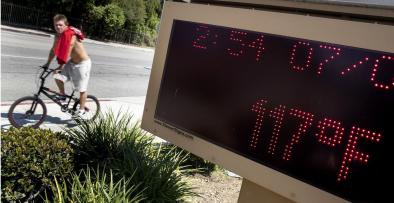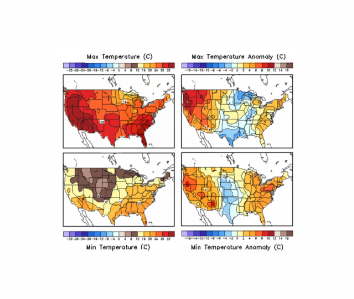Southern California Heat Wave July 2018
A historic heat wave obliterated records across southern California on July 6, 2018. Many locations recorded temperatures 10° to 15°F higher than the previous daily record. Monthly and all-time heat records were also set in many locations.[1][2][3] Record breaking heat waves are a classic signal of climate change.
This heat wave occurred less than one year after California experienced its all-time greatest statewide heat wave. The past year has witnessed a global wave of record-breaking extreme heat including the highest overnight temperature ever recorded.[4]







Climate science at a glance
- The increasing frequency and intensity of heat waves is among the most obvious and well-documented effects of climate change.[1]
- An attribution study led by Stanford’s Noah Diffenbaugh has identified the fingerprint of climate change on extreme heat in California.[2]
- Climate change increased the chances of this heat wave by about 20 to 50 times, according to an estimate by Michael Wehner.[3]
Climate signal breakdown
Climate signal #1: extreme heat
Extreme heat and heat waves in the United States and around the world are some of the clearest impacts of climate change on extreme weather. The fingerprint of global warming has been firmly identified in the increasing intensity, duration and frequency of extreme heat events in the United States and globally.
Hot nights are particularly characteristic of climate change on a warming planet. There has been a dramatic increase in hot night-time temperatures in the US, reducing the number of critically important relief windows during heat waves.[4]
Observations consistent with climate signal #1
- On July 6, the hottest all-time temperature on record occurred at UCLA (111°F), Burbank Airport (114°F), Van Nuys Airport (117°F), Ramona (117°F), Santa Ana (114°F), and Riverside (118°F, tying the record from 1925).[5][6]
- 82°F: Hottest all-time overnight low temperature on record for any month in Burbank, California.[3]
- 79°F: Hottest overnight low temperature on record for the month of July in Los Angeles on July 7.[3]
- 120° F: Highest temperature — set in Chino on July 6 — ever recorded by any automated weather station in the valleys or coastal areas around Orange, Riverside, San Bernardino and San Diego Counties.[3]

Climate signal breakdown
 Climate signal #2: atmospheric blocking increase
Climate signal #2: atmospheric blocking increase
The extreme heat observed on July 6 and 7 in southern California occurred against a backdrop of more-intense hot-air masses due to climate change.[7]
Studies have shown that the strength of these hot, high-pressure air masses (sometimes referred to as "heat domes") has trended upward in recent decades. One analysis identifies an increase in the intensity of heat domes over the entire Northern Hemisphere during the summer months from 1979 to 2010.[8]
Observations consistent with climate signal #2
- The most intense heat domes, which are historically very rare, feature geopotential heights exceeding 6,000 meters at their core. The heat dome on July 6 exceeded the 6,000-meter geopotential height threshold in several locations in the Western United States.[9]











